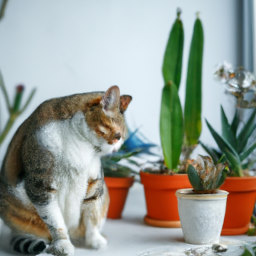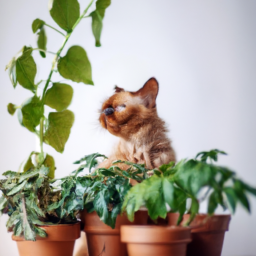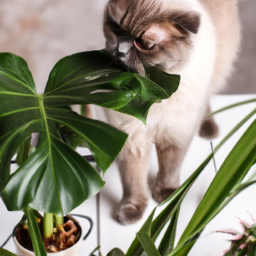
Are indoor plants safe for cats? This is a question that many cat owners find themselves asking. While indoor plants can add beauty and freshness to your home, they can also pose a potential risk to your feline friends. As a responsible pet owner, it’s crucial to be aware of the plants that can be harmful to cats and take necessary precautions to keep them safe. In this blog post, we will explore the topic of whether indoor plants are safe for cats, highlighting some common plants that can be toxic to them and providing tips on how to create a cat-friendly indoor garden. So, if you’re a plant lover and a cat owner, keep reading to ensure a safe and harmonious environment for both your plants and your furry companions.
Potential Dangers of Indoor Plants for Cats
As a cat owner, it’s important to be aware of the potential dangers that indoor plants can pose to your feline friend. While plants can add beauty and freshness to your home, some varieties can be toxic to cats if ingested. In this guide, we will explore the potential risks associated with indoor plants and provide you with a step-by-step approach to creating a safe environment for your beloved pet.
Understanding Toxicity in Indoor Plants
Before delving into the specific plants that can be harmful to cats, it’s crucial to understand how toxicity works. Different plants contain various substances that can be toxic to cats, such as alkaloids, glycosides, or essential oils. When a cat ingests these substances, it can lead to mild to severe symptoms, ranging from gastrointestinal upset to organ failure.
It’s important to note that not all cats will have the same reaction to a toxic plant. Some may show immediate signs of illness, while others may exhibit no symptoms at all. However, it’s always better to err on the side of caution and ensure that your home is free from potentially harmful plants.
Now, let’s explore some common indoor plants that can pose a risk to your furry friend:
1. Lilies
Lilies are undeniably beautiful, but they are highly toxic to cats, especially true lilies (Lilium spp.) and daylilies (Hemerocallis spp.). Ingesting any part of these plants, including the leaves, flowers, or even the pollen, can lead to kidney failure in cats. Even a small nibble can have severe consequences, so it’s best to avoid having lilies in your home if you have a cat.
If you suspect your cat has ingested any part of a lily, it’s crucial to seek immediate veterinary attention. Early intervention can significantly increase the chances of a positive outcome.
2. Philodendron
Philodendrons are popular houseplants known for their attractive foliage. However, these plants contain insoluble calcium oxalate crystals, which can cause oral irritation, intense burning, and swelling of the mouth, tongue, and lips if chewed or ingested by cats. Symptoms may include drooling, difficulty swallowing, and vomiting.
If you have a philodendron in your home, make sure it’s placed out of reach of your cat or consider opting for a cat-safe alternative.
3. Sago Palm
The sago palm (Cycas revoluta) is a common indoor plant that can be highly toxic to cats. All parts of the plant, including the seeds, leaves, and roots, contain cycasin, a toxin that can cause severe liver damage if ingested. Symptoms may include vomiting, diarrhea, jaundice, and even liver failure.
If you suspect your cat has ingested any part of a sago palm, contact your veterinarian immediately. Time is of the essence when dealing with potential liver toxicities.
Creating a Safe Environment for Your Cat
Now that you’re aware of some common indoor plants that can pose a risk to your cat’s health, it’s time to take action and create a safe environment for your furry friend. Follow these steps to ensure your home is free from potentially toxic plants:
1. Research and identify cat-safe plants: There are plenty of beautiful indoor plants that are safe for cats. Research and choose cat-friendly alternatives to bring greenery into your home. Some safe options include spider plants, Boston ferns, and African violets.
2. Remove toxic plants from your home: If you currently have any toxic plants in your home, it’s best to remove them or place them in areas that are completely inaccessible to your cat. Remember, cats are curious creatures and can find their way into unexpected places.
3. Secure hanging plants: If you have hanging plants, ensure they are securely hung and out of your cat’s reach. Cats love to climb and explore, so taking this precaution can prevent any accidental ingestion of toxic plants.
4. Monitor your cat’s behavior: Keep a close eye on your cat’s behavior, especially if you introduce new plants into your home. If you notice any signs of illness, such as vomiting, diarrhea, or lethargy, contact your veterinarian immediately.
By following these steps and being mindful of the potential dangers associated with indoor plants, you can create a safe and cat-friendly environment in your home. Remember, prevention is key when it comes to protecting your feline companion from potential plant-related hazards.
Always consult with your veterinarian if you have any concerns about the safety of specific plants or if your cat shows any signs of illness after potential exposure to toxic plants.

Safe Indoor Plants for Cat Owners
Are you a proud cat owner who also loves having indoor plants? It’s important to ensure that the plants you bring into your home are safe for your feline friends. While some plants can be toxic to cats, there are plenty of options that are both beautiful and pet-friendly. In this article, we will explore some safe indoor plants for cat owners, allowing you to create a green and cat-friendly environment in your home.
1. Spider Plant (Chlorophytum comosum)
The spider plant is a popular choice for indoor gardening enthusiasts, and the good news is that it is non-toxic to cats. This plant features long, arching leaves that are green with white stripes, creating an attractive visual appeal. Spider plants are known for their ability to purify the air, making them a great addition to any home.
When it comes to caring for your spider plant, make sure to place it in a well-lit area, but away from direct sunlight. Keep the soil moist but not overly wet, and be sure to trim any brown or yellow leaves to maintain its health. With proper care, your spider plant and your cat can coexist peacefully.
If you notice that your cat shows interest in chewing on the spider plant, you can discourage this behavior by providing alternative chew toys or using bitter sprays that are safe for cats. Remember, it’s always better to be safe than sorry when it comes to your furry friend’s well-being.
2. Boston Fern (Nephrolepis exaltata)
The Boston fern is a beautiful and pet-friendly plant that can add a touch of elegance to your indoor space. Its lush green fronds create a stunning display, and the best part is that it is non-toxic to cats. This makes it a perfect choice for cat owners who want to bring some greenery into their homes.
To keep your Boston fern healthy, place it in a spot with indirect sunlight. These plants thrive in humid environments, so misting the leaves occasionally can help maintain the required moisture levels. It’s important to keep the soil consistently moist but not soggy. With proper care, your Boston fern will flourish, and your cat will have a safe and stylish environment to explore.
If your cat has a tendency to dig or play with the fern, you can try placing decorative rocks on the soil surface to discourage this behavior. Additionally, providing your cat with other engaging toys and scratching posts can redirect their attention away from the plants.
3. Areca Palm (Dypsis lutescens)
The Areca palm, also known as the butterfly palm, is a cat-friendly plant that can bring a tropical vibe to your indoor space. With its feathery, arching fronds, it adds a touch of elegance and freshness to any room. Fortunately, this plant is non-toxic to cats, so you can enjoy its beauty without worrying about your furry friend’s safety.
When it comes to caring for your Areca palm, it’s important to place it in a well-lit area, but away from direct sunlight. These plants prefer slightly moist soil, so make sure to water them regularly. However, be cautious not to overwater, as this can lead to root rot.
As with any indoor plant, it’s a good idea to monitor your cat’s behavior around the Areca palm. If your cat shows excessive interest in chewing or playing with the plant, you may need to take measures to deter this behavior. Providing appropriate toys and environmental enrichment can help keep your cat entertained and less likely to engage with the plants.
Remember, even though these plants are considered safe for cats, individual cats may still have different reactions or sensitivities. If you notice any unusual symptoms in your cat after introducing a new plant, it’s always best to consult with your veterinarian.
In conclusion, having indoor plants doesn’t mean you have to compromise your cat’s safety. By choosing cat-friendly plants such as spider plants, Boston ferns, and Areca palms, you can create a beautiful and pet-friendly environment in your home. Just remember to provide proper care for the plants and monitor your cat’s behavior to ensure a harmonious coexistence between your furry friend and your green companions.

Precautions to Take with Indoor Plants and Cats
Indoor plants can add beauty and freshness to your home, but as a responsible cat owner, it’s crucial to ensure that the plants you bring indoors are safe for your feline friend. While many plants are harmless, some can be toxic or cause discomfort if ingested by cats. In this article, we will discuss important precautions to take when it comes to indoor plants and cats, ensuring a safe and harmonious environment for both you and your furry companion.
1. Research and Identify Cat-Friendly Plants
Before bringing any new plants into your home, it’s essential to research and identify cat-friendly options. There are numerous indoor plants that are non-toxic to cats, such as Boston Fern, Spider Plant, and Areca Palm. These plants not only add greenery to your space but also provide a safe environment for your furry friend.
When selecting plants, consider their toxicity levels. Some plants may only cause mild digestive upset, while others can be highly poisonous and lead to severe health issues. Avoid plants like lilies, azaleas, and philodendrons, which are known to be toxic to cats.
Furthermore, it’s crucial to remember that some cats have a tendency to chew on plants. Even if a plant is non-toxic, chewing on leaves or flowers can still cause gastrointestinal irritation or other discomfort. Therefore, it’s wise to observe your cat’s behavior and keep an eye on their interactions with plants.
2. Create a Safe Environment
While it’s essential to choose cat-friendly plants, it’s equally important to create a safe environment for your cat to prevent any unwanted interactions with the plants. Here are a few simple steps you can take:
A. Placement: Keep plants out of your cat’s reach by placing them on high shelves, hanging them from the ceiling, or using plant stands. This will prevent your cat from accessing the plants and potentially causing harm.
B. Physical barriers: If you have particularly curious or mischievous cats, consider using physical barriers like baby gates or plant enclosures to restrict access to certain areas of your home where plants are kept.
C. Deterrents: Cats are naturally curious, so using deterrents can be helpful in keeping them away from plants. Natural deterrents like citrus peels, aluminum foil, or double-sided tape can discourage your cat from approaching the plants.
D. Training: Training your cat to stay away from plants can be challenging but rewarding. Use positive reinforcement techniques to redirect their attention and provide them with appropriate toys and scratching posts to keep them engaged and entertained.
3. Recognize the Signs of Plant Toxicity
Despite your best efforts, accidents can still happen. It’s crucial to familiarize yourself with the signs of plant toxicity in cats so that you can take immediate action if necessary. Some common signs of plant toxicity include:
A. Gastrointestinal upset: Vomiting, diarrhea, drooling, and loss of appetite are common symptoms of plant ingestion. If you notice any of these signs, contact your veterinarian immediately.
B. Behavioral changes: Lethargy, excessive vocalization, agitation, or unusual behavior can indicate plant toxicity. Pay attention to any changes in your cat’s behavior and seek veterinary assistance if needed.
C. Respiratory distress: Some plants can cause respiratory issues in cats. If you notice coughing, wheezing, or difficulty breathing, it could be a sign of plant toxicity, and prompt veterinary care is necessary.
If you suspect that your cat has ingested a toxic plant, do not attempt to induce vomiting or administer any home remedies without veterinary guidance. Contact your veterinarian or a pet poison helpline immediately for professional advice.
Remember, prevention is always better than cure when it comes to the safety of your cat. By choosing cat-friendly plants, creating a safe environment, and being vigilant about potential plant toxicity, you can ensure a happy and healthy life for your furry companion.
Let’s recap
Indoor plants can be a great addition to any home, bringing a touch of nature and improving air quality. However, if you’re a cat owner, you may have concerns about whether these plants are safe for your furry friend. The good news is that many indoor plants are non-toxic to cats, but it’s important to be aware of the ones that can be harmful.
Some common indoor plants that are safe for cats include spider plants, Boston ferns, and African violets. These plants not only add beauty to your space but also provide a safe environment for your curious feline. However, it’s crucial to avoid plants like lilies, which are highly toxic to cats and can cause kidney failure if ingested. Other plants to keep away from your furry friend include pothos, philodendron, and snake plants, as they can cause vomiting, diarrhea, or even more severe symptoms.
Here are the top questions that we were asked:
Q1: Are indoor plants safe for cats?
A1: Yes, many indoor plants are safe for cats. However, it’s important to note that some plants can be toxic to cats if ingested. To ensure your feline friend’s safety, it’s best to choose non-toxic plants and keep toxic ones out of their reach.
Q2: Which indoor plants are safe for cats?
A2: There are several indoor plants that are considered safe for cats. Some popular options include spider plants, Boston ferns, African violets, and areca palms. These plants are not known to be toxic to cats and can add a touch of greenery to your home without posing a risk to your furry friend.
Q3: How can I determine if a plant is toxic to cats?
A3: To determine if a plant is toxic to cats, it’s best to consult a reliable source such as the ASPCA’s website or reach out to your veterinarian. These resources provide comprehensive lists of toxic and non-toxic plants. Additionally, you can also consider purchasing plants labeled as “pet-friendly” or “non-toxic” to ensure they are safe for your cat.
Q4: What are the signs of plant poisoning in cats?
A4: If your cat has ingested a toxic plant, they may exhibit symptoms such as vomiting, diarrhea, drooling, difficulty breathing, lethargy, or changes in appetite. If you suspect your cat has been poisoned, it’s important to seek immediate veterinary care.
Q5: How can I keep my cat safe around indoor plants?
A5: To keep your cat safe around indoor plants, you can take a few precautions. Firstly, make sure to research the plants you have or plan to bring into your home to ensure they are non-toxic to cats. Place toxic plants in areas that are completely inaccessible to your cat, such as high shelves or hanging baskets. You can also deter your cat from chewing on plants by providing them with alternative safe toys and ensuring they have a well-balanced diet to discourage plant nibbling.
Dr. Olivia Green is a botanist with over two decades of experience in indoor plant cultivation. She holds a Ph.D. in Plant Biology and has dedicated her career to researching plant behavior in controlled environments. Dr. Green is passionate about helping plant enthusiasts master the art of indoor gardening through her extensive knowledge and practical insights.


